CHEVROLET CITY EXPRESS 2018 Owner's Manual
Manufacturer: CHEVROLET, Model Year: 2018, Model line: CITY EXPRESS, Model: CHEVROLET CITY EXPRESS 2018Pages: 287, PDF Size: 4.19 MB
Page 151 of 287
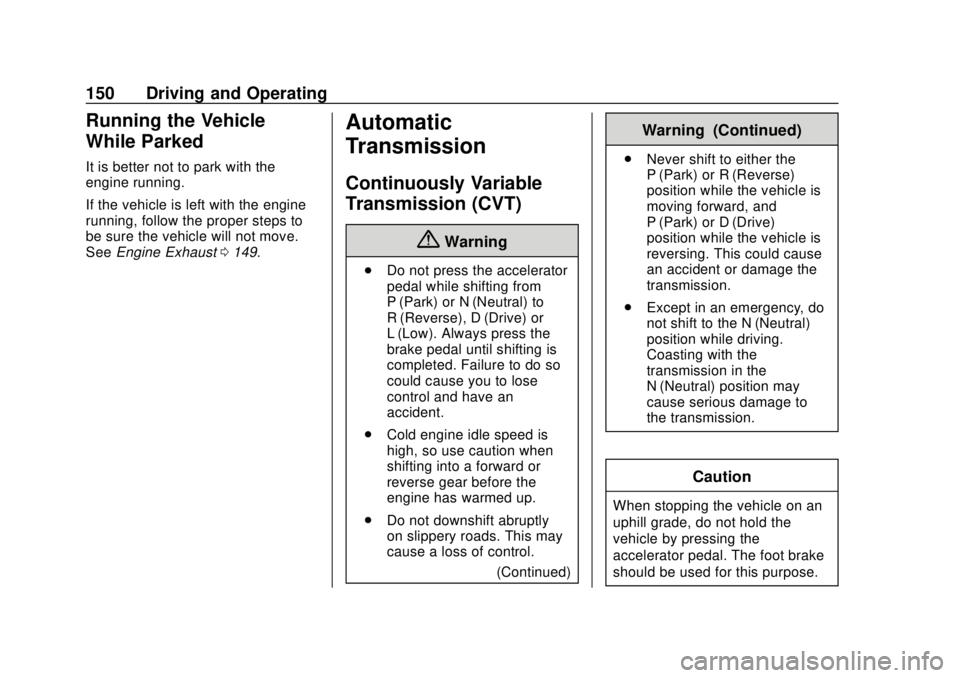
Chevrolet City Express Owner Manual (GMNA-Localizing-U.S./Canada-
11683523) - 2018 - CRC - 7/10/17
150 Driving and Operating
Running the Vehicle
While Parked
It is better not to park with the
engine running.
If the vehicle is left with the engine
running, follow the proper steps to
be sure the vehicle will not move.
SeeEngine Exhaust 0149.
Automatic
Transmission
Continuously Variable
Transmission (CVT)
{Warning
.
Do not press the accelerator
pedal while shifting from
P (Park) or N (Neutral) to
R (Reverse), D (Drive) or
L (Low). Always press the
brake pedal until shifting is
completed. Failure to do so
could cause you to lose
control and have an
accident.
. Cold engine idle speed is
high, so use caution when
shifting into a forward or
reverse gear before the
engine has warmed up.
. Do not downshift abruptly
on slippery roads. This may
cause a loss of control.
(Continued)
Warning (Continued)
.Never shift to either the
P (Park) or R (Reverse)
position while the vehicle is
moving forward, and
P (Park) or D (Drive)
position while the vehicle is
reversing. This could cause
an accident or damage the
transmission.
. Except in an emergency, do
not shift to the N (Neutral)
position while driving.
Coasting with the
transmission in the
N (Neutral) position may
cause serious damage to
the transmission.
Caution
When stopping the vehicle on an
uphill grade, do not hold the
vehicle by pressing the
accelerator pedal. The foot brake
should be used for this purpose.
Page 152 of 287
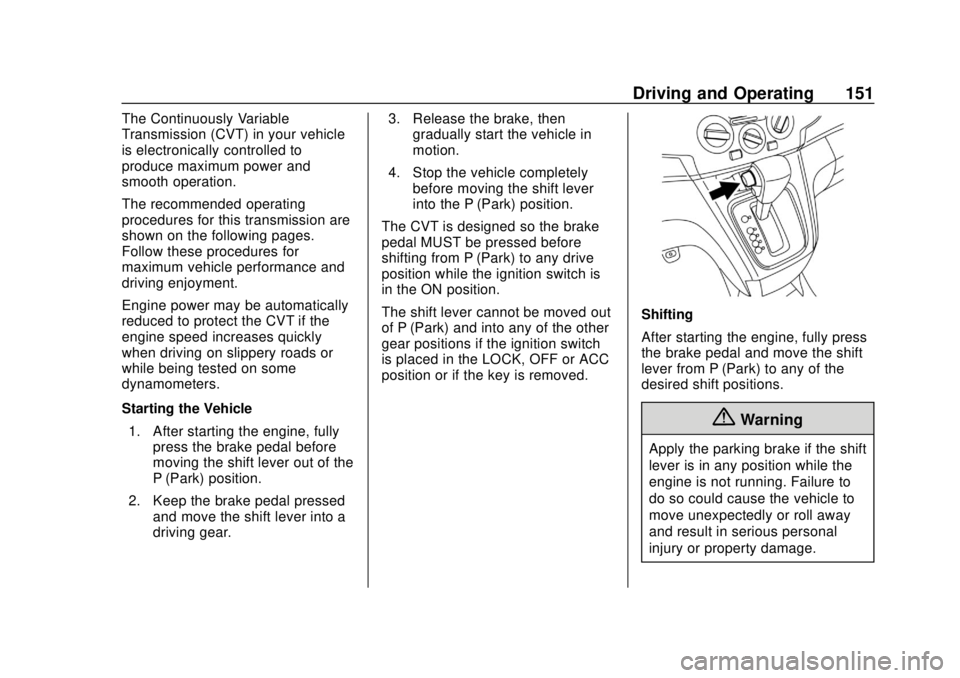
Chevrolet City Express Owner Manual (GMNA-Localizing-U.S./Canada-
11683523) - 2018 - CRC - 7/10/17
Driving and Operating 151
The Continuously Variable
Transmission (CVT) in your vehicle
is electronically controlled to
produce maximum power and
smooth operation.
The recommended operating
procedures for this transmission are
shown on the following pages.
Follow these procedures for
maximum vehicle performance and
driving enjoyment.
Engine power may be automatically
reduced to protect the CVT if the
engine speed increases quickly
when driving on slippery roads or
while being tested on some
dynamometers.
Starting the Vehicle1. After starting the engine, fully press the brake pedal before
moving the shift lever out of the
P (Park) position.
2. Keep the brake pedal pressed and move the shift lever into a
driving gear. 3. Release the brake, then
gradually start the vehicle in
motion.
4. Stop the vehicle completely before moving the shift lever
into the P (Park) position.
The CVT is designed so the brake
pedal MUST be pressed before
shifting from P (Park) to any drive
position while the ignition switch is
in the ON position.
The shift lever cannot be moved out
of P (Park) and into any of the other
gear positions if the ignition switch
is placed in the LOCK, OFF or ACC
position or if the key is removed.
Shifting
After starting the engine, fully press
the brake pedal and move the shift
lever from P (Park) to any of the
desired shift positions.
{Warning
Apply the parking brake if the shift
lever is in any position while the
engine is not running. Failure to
do so could cause the vehicle to
move unexpectedly or roll away
and result in serious personal
injury or property damage.
Page 153 of 287
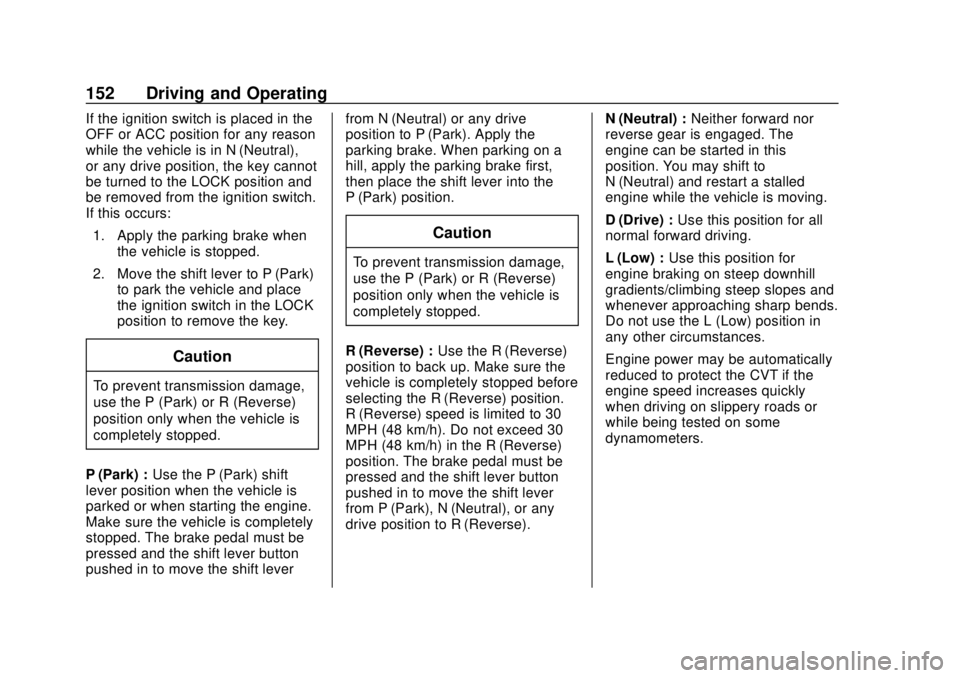
Chevrolet City Express Owner Manual (GMNA-Localizing-U.S./Canada-
11683523) - 2018 - CRC - 7/10/17
152 Driving and Operating
If the ignition switch is placed in the
OFF or ACC position for any reason
while the vehicle is in N (Neutral),
or any drive position, the key cannot
be turned to the LOCK position and
be removed from the ignition switch.
If this occurs:1. Apply the parking brake when the vehicle is stopped.
2. Move the shift lever to P (Park) to park the vehicle and place
the ignition switch in the LOCK
position to remove the key.
Caution
To prevent transmission damage,
use the P (Park) or R (Reverse)
position only when the vehicle is
completely stopped.
P (Park) : Use the P (Park) shift
lever position when the vehicle is
parked or when starting the engine.
Make sure the vehicle is completely
stopped. The brake pedal must be
pressed and the shift lever button
pushed in to move the shift lever from N (Neutral) or any drive
position to P (Park). Apply the
parking brake. When parking on a
hill, apply the parking brake first,
then place the shift lever into the
P (Park) position.
Caution
To prevent transmission damage,
use the P (Park) or R (Reverse)
position only when the vehicle is
completely stopped.
R (Reverse) : Use the R (Reverse)
position to back up. Make sure the
vehicle is completely stopped before
selecting the R (Reverse) position.
R (Reverse) speed is limited to 30
MPH (48 km/h). Do not exceed 30
MPH (48 km/h) in the R (Reverse)
position. The brake pedal must be
pressed and the shift lever button
pushed in to move the shift lever
from P (Park), N (Neutral), or any
drive position to R (Reverse). N (Neutral) :
Neither forward nor
reverse gear is engaged. The
engine can be started in this
position. You may shift to
N (Neutral) and restart a stalled
engine while the vehicle is moving.
D (Drive) : Use this position for all
normal forward driving.
L (Low) : Use this position for
engine braking on steep downhill
gradients/climbing steep slopes and
whenever approaching sharp bends.
Do not use the L (Low) position in
any other circumstances.
Engine power may be automatically
reduced to protect the CVT if the
engine speed increases quickly
when driving on slippery roads or
while being tested on some
dynamometers.
Page 154 of 287
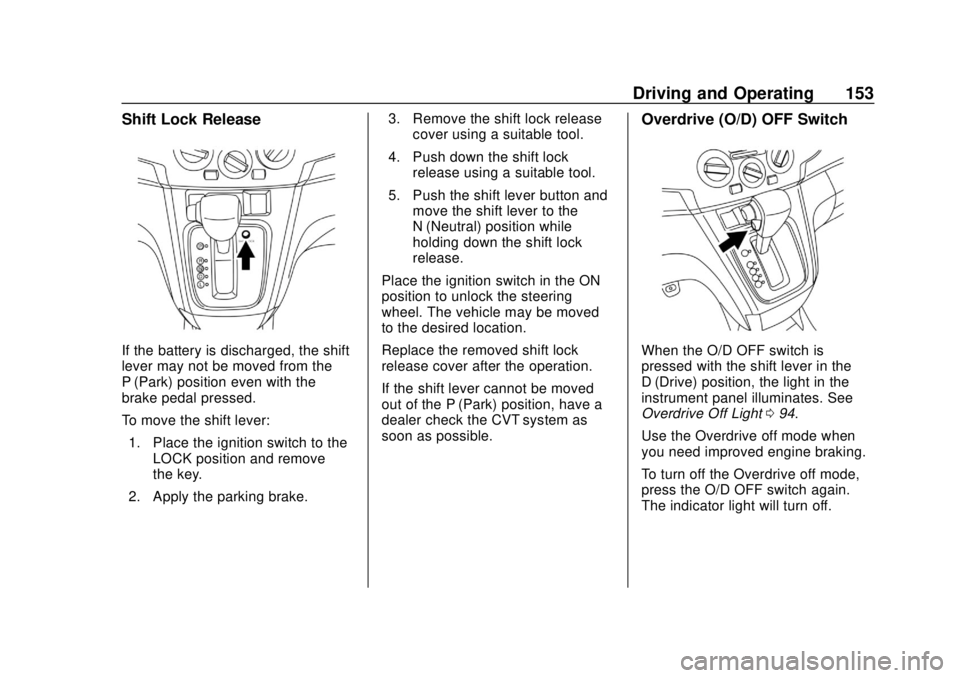
Chevrolet City Express Owner Manual (GMNA-Localizing-U.S./Canada-
11683523) - 2018 - CRC - 7/10/17
Driving and Operating 153
Shift Lock Release
If the battery is discharged, the shift
lever may not be moved from the
P (Park) position even with the
brake pedal pressed.
To move the shift lever:1. Place the ignition switch to the LOCK position and remove
the key.
2. Apply the parking brake. 3. Remove the shift lock release
cover using a suitable tool.
4. Push down the shift lock release using a suitable tool.
5. Push the shift lever button and move the shift lever to the
N (Neutral) position while
holding down the shift lock
release.
Place the ignition switch in the ON
position to unlock the steering
wheel. The vehicle may be moved
to the desired location.
Replace the removed shift lock
release cover after the operation.
If the shift lever cannot be moved
out of the P (Park) position, have a
dealer check the CVT system as
soon as possible.
Overdrive (O/D) OFF Switch
When the O/D OFF switch is
pressed with the shift lever in the
D (Drive) position, the light in the
instrument panel illuminates. See
Overdrive Off Light 094.
Use the Overdrive off mode when
you need improved engine braking.
To turn off the Overdrive off mode,
press the O/D OFF switch again.
The indicator light will turn off.
Page 155 of 287
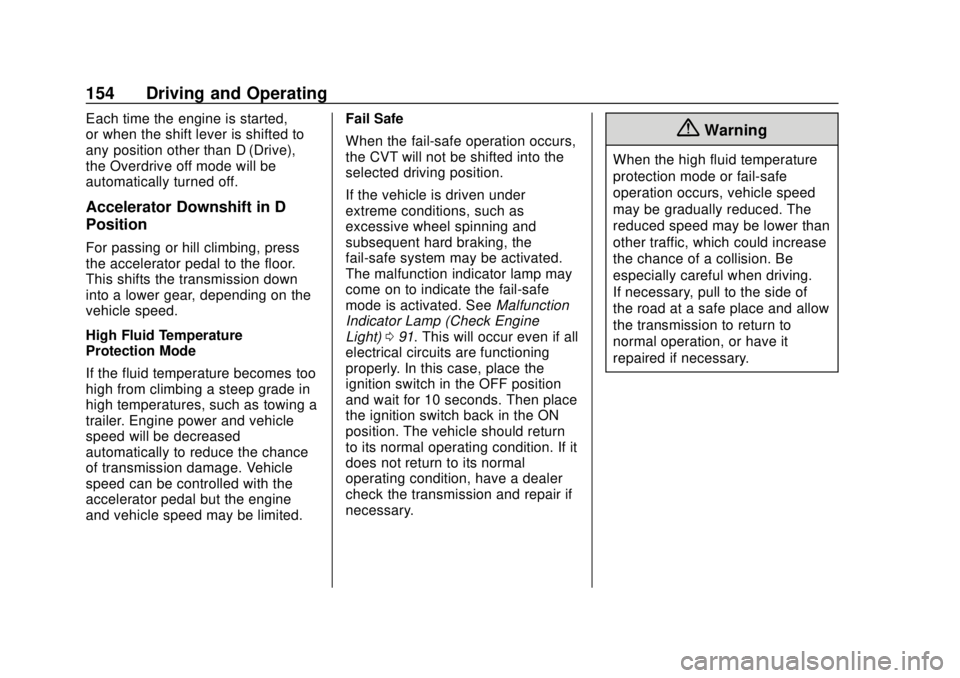
Chevrolet City Express Owner Manual (GMNA-Localizing-U.S./Canada-
11683523) - 2018 - CRC - 7/10/17
154 Driving and Operating
Each time the engine is started,
or when the shift lever is shifted to
any position other than D (Drive),
the Overdrive off mode will be
automatically turned off.
Accelerator Downshift in D
Position
For passing or hill climbing, press
the accelerator pedal to the floor.
This shifts the transmission down
into a lower gear, depending on the
vehicle speed.
High Fluid Temperature
Protection Mode
If the fluid temperature becomes too
high from climbing a steep grade in
high temperatures, such as towing a
trailer. Engine power and vehicle
speed will be decreased
automatically to reduce the chance
of transmission damage. Vehicle
speed can be controlled with the
accelerator pedal but the engine
and vehicle speed may be limited.Fail Safe
When the fail-safe operation occurs,
the CVT will not be shifted into the
selected driving position.
If the vehicle is driven under
extreme conditions, such as
excessive wheel spinning and
subsequent hard braking, the
fail-safe system may be activated.
The malfunction indicator lamp may
come on to indicate the fail-safe
mode is activated. See
Malfunction
Indicator Lamp (Check Engine
Light) 091. This will occur even if all
electrical circuits are functioning
properly. In this case, place the
ignition switch in the OFF position
and wait for 10 seconds. Then place
the ignition switch back in the ON
position. The vehicle should return
to its normal operating condition. If it
does not return to its normal
operating condition, have a dealer
check the transmission and repair if
necessary.
{Warning
When the high fluid temperature
protection mode or fail-safe
operation occurs, vehicle speed
may be gradually reduced. The
reduced speed may be lower than
other traffic, which could increase
the chance of a collision. Be
especially careful when driving.
If necessary, pull to the side of
the road at a safe place and allow
the transmission to return to
normal operation, or have it
repaired if necessary.
Page 156 of 287
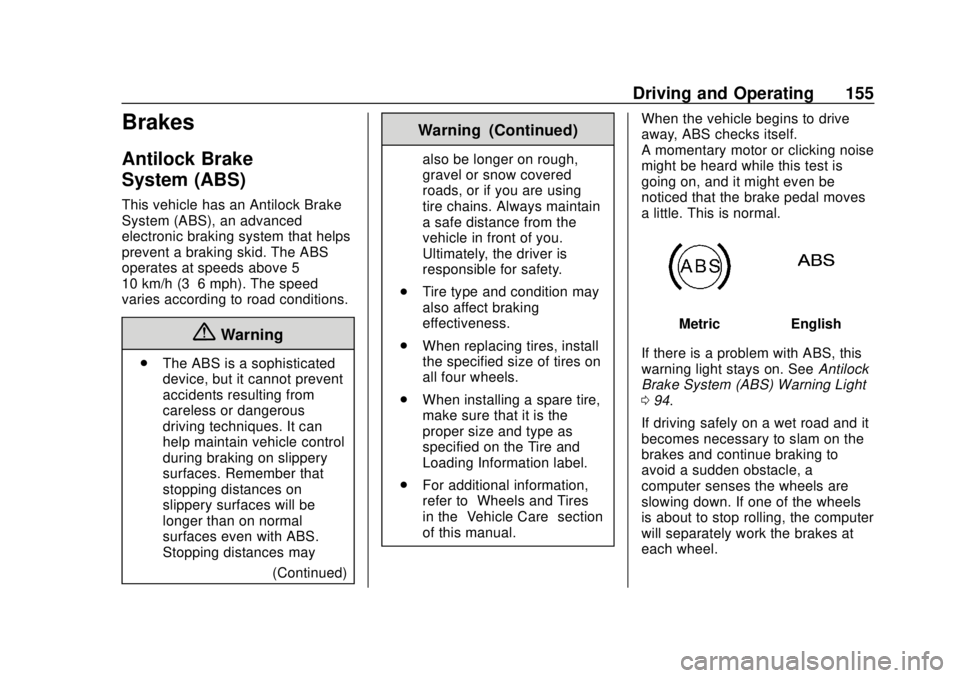
Chevrolet City Express Owner Manual (GMNA-Localizing-U.S./Canada-
11683523) - 2018 - CRC - 7/10/17
Driving and Operating 155
Brakes
Antilock Brake
System (ABS)
This vehicle has an Antilock Brake
System (ABS), an advanced
electronic braking system that helps
prevent a braking skid. The ABS
operates at speeds above 5–
10 km/h (3–6 mph). The speed
varies according to road conditions.
{Warning
.The ABS is a sophisticated
device, but it cannot prevent
accidents resulting from
careless or dangerous
driving techniques. It can
help maintain vehicle control
during braking on slippery
surfaces. Remember that
stopping distances on
slippery surfaces will be
longer than on normal
surfaces even with ABS.
Stopping distances may
(Continued)
Warning (Continued)
also be longer on rough,
gravel or snow covered
roads, or if you are using
tire chains. Always maintain
a safe distance from the
vehicle in front of you.
Ultimately, the driver is
responsible for safety.
. Tire type and condition may
also affect braking
effectiveness.
. When replacing tires, install
the specified size of tires on
all four wheels.
. When installing a spare tire,
make sure that it is the
proper size and type as
specified on the Tire and
Loading Information label.
. For additional information,
refer to “Wheels and Tires”
in the “Vehicle Care” section
of this manual. When the vehicle begins to drive
away, ABS checks itself.
A momentary motor or clicking noise
might be heard while this test is
going on, and it might even be
noticed that the brake pedal moves
a little. This is normal.
MetricEnglish
If there is a problem with ABS, this
warning light stays on. See Antilock
Brake System (ABS) Warning Light
0 94.
If driving safely on a wet road and it
becomes necessary to slam on the
brakes and continue braking to
avoid a sudden obstacle, a
computer senses the wheels are
slowing down. If one of the wheels
is about to stop rolling, the computer
will separately work the brakes at
each wheel.
Page 157 of 287
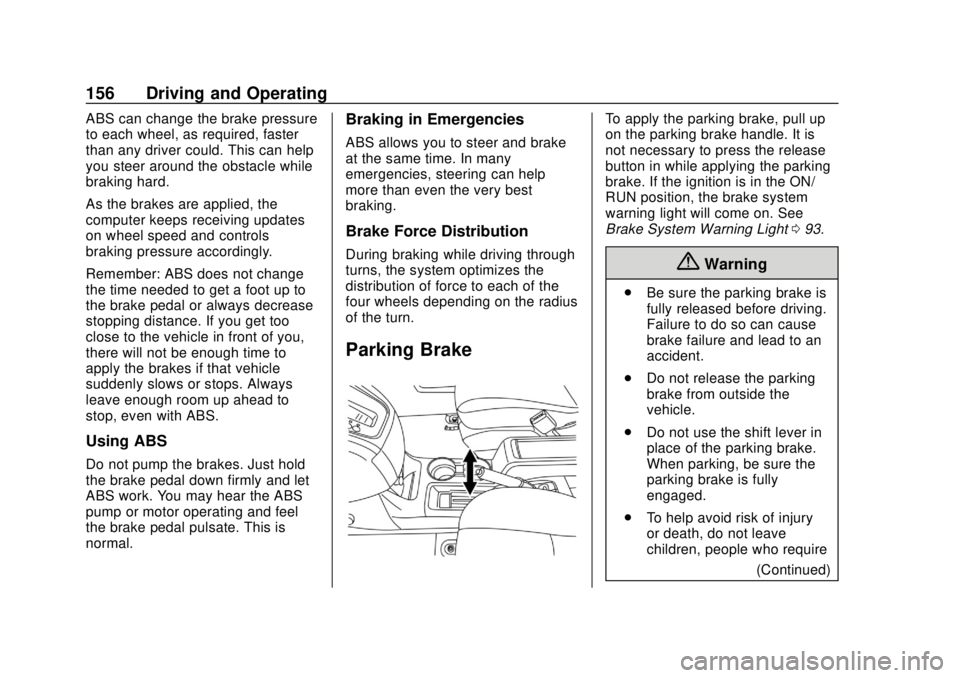
Chevrolet City Express Owner Manual (GMNA-Localizing-U.S./Canada-
11683523) - 2018 - CRC - 7/10/17
156 Driving and Operating
ABS can change the brake pressure
to each wheel, as required, faster
than any driver could. This can help
you steer around the obstacle while
braking hard.
As the brakes are applied, the
computer keeps receiving updates
on wheel speed and controls
braking pressure accordingly.
Remember: ABS does not change
the time needed to get a foot up to
the brake pedal or always decrease
stopping distance. If you get too
close to the vehicle in front of you,
there will not be enough time to
apply the brakes if that vehicle
suddenly slows or stops. Always
leave enough room up ahead to
stop, even with ABS.
Using ABS
Do not pump the brakes. Just hold
the brake pedal down firmly and let
ABS work. You may hear the ABS
pump or motor operating and feel
the brake pedal pulsate. This is
normal.
Braking in Emergencies
ABS allows you to steer and brake
at the same time. In many
emergencies, steering can help
more than even the very best
braking.
Brake Force Distribution
During braking while driving through
turns, the system optimizes the
distribution of force to each of the
four wheels depending on the radius
of the turn.
Parking Brake
To apply the parking brake, pull up
on the parking brake handle. It is
not necessary to press the release
button in while applying the parking
brake. If the ignition is in the ON/
RUN position, the brake system
warning light will come on. See
Brake System Warning Light093.
{Warning
.
Be sure the parking brake is
fully released before driving.
Failure to do so can cause
brake failure and lead to an
accident.
. Do not release the parking
brake from outside the
vehicle.
. Do not use the shift lever in
place of the parking brake.
When parking, be sure the
parking brake is fully
engaged.
. To help avoid risk of injury
or death, do not leave
children, people who require
(Continued)
Page 158 of 287
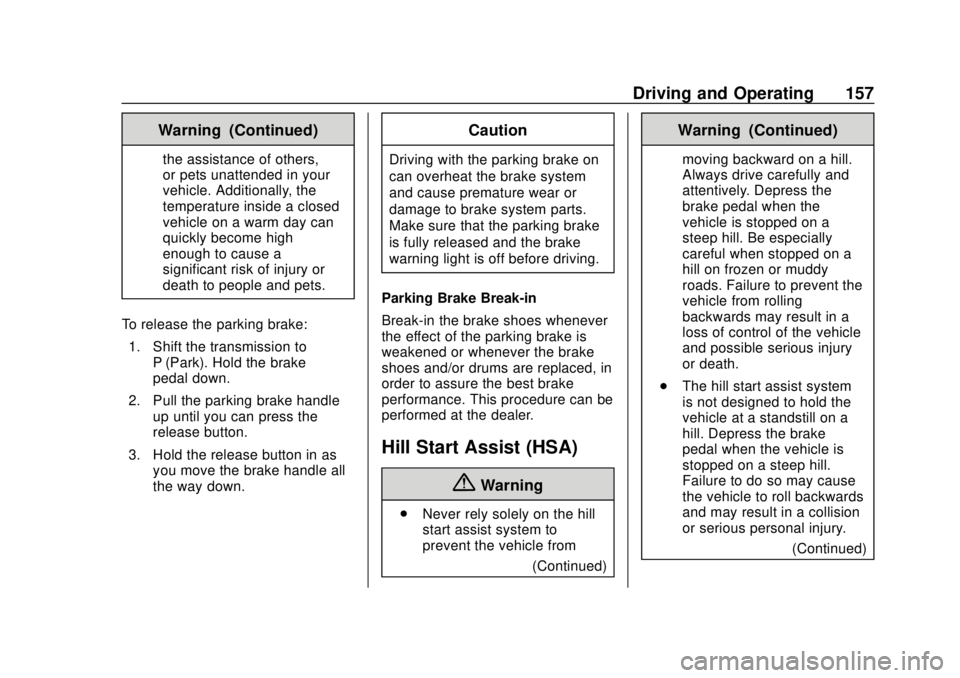
Chevrolet City Express Owner Manual (GMNA-Localizing-U.S./Canada-
11683523) - 2018 - CRC - 7/10/17
Driving and Operating 157
Warning (Continued)
the assistance of others,
or pets unattended in your
vehicle. Additionally, the
temperature inside a closed
vehicle on a warm day can
quickly become high
enough to cause a
significant risk of injury or
death to people and pets.
To release the parking brake: 1. Shift the transmission to P (Park). Hold the brake
pedal down.
2. Pull the parking brake handle up until you can press the
release button.
3. Hold the release button in as you move the brake handle all
the way down.
Caution
Driving with the parking brake on
can overheat the brake system
and cause premature wear or
damage to brake system parts.
Make sure that the parking brake
is fully released and the brake
warning light is off before driving.
Parking Brake Break-in
Break-in the brake shoes whenever
the effect of the parking brake is
weakened or whenever the brake
shoes and/or drums are replaced, in
order to assure the best brake
performance. This procedure can be
performed at the dealer.
Hill Start Assist (HSA)
{Warning
. Never rely solely on the hill
start assist system to
prevent the vehicle from
(Continued)
Warning (Continued)
moving backward on a hill.
Always drive carefully and
attentively. Depress the
brake pedal when the
vehicle is stopped on a
steep hill. Be especially
careful when stopped on a
hill on frozen or muddy
roads. Failure to prevent the
vehicle from rolling
backwards may result in a
loss of control of the vehicle
and possible serious injury
or death.
. The hill start assist system
is not designed to hold the
vehicle at a standstill on a
hill. Depress the brake
pedal when the vehicle is
stopped on a steep hill.
Failure to do so may cause
the vehicle to roll backwards
and may result in a collision
or serious personal injury.
(Continued)
Page 159 of 287
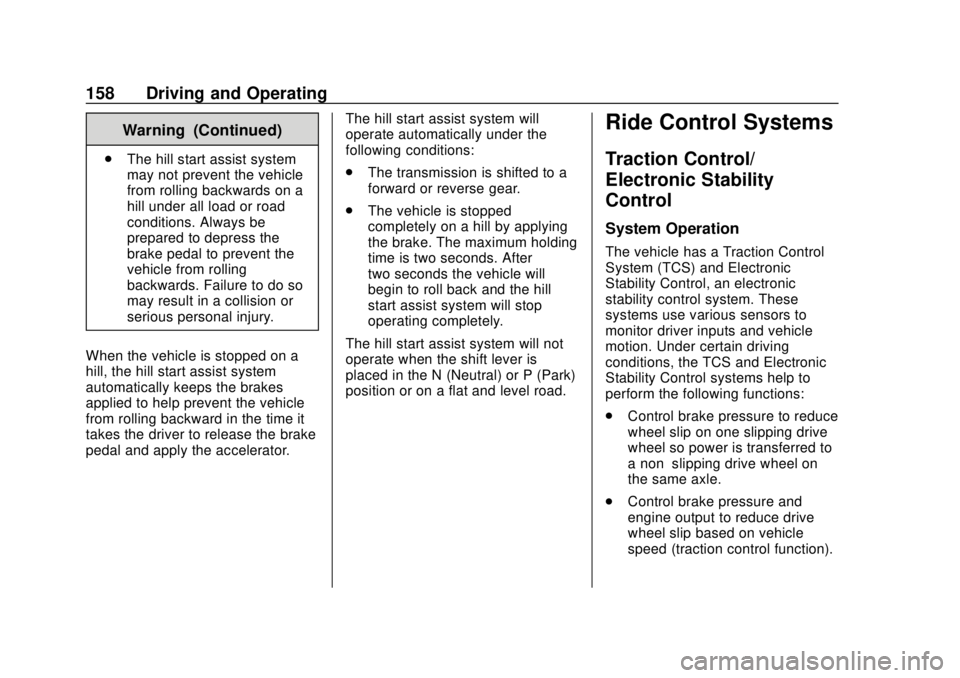
Chevrolet City Express Owner Manual (GMNA-Localizing-U.S./Canada-
11683523) - 2018 - CRC - 7/10/17
158 Driving and Operating
Warning (Continued)
.The hill start assist system
may not prevent the vehicle
from rolling backwards on a
hill under all load or road
conditions. Always be
prepared to depress the
brake pedal to prevent the
vehicle from rolling
backwards. Failure to do so
may result in a collision or
serious personal injury.
When the vehicle is stopped on a
hill, the hill start assist system
automatically keeps the brakes
applied to help prevent the vehicle
from rolling backward in the time it
takes the driver to release the brake
pedal and apply the accelerator. The hill start assist system will
operate automatically under the
following conditions:
.
The transmission is shifted to a
forward or reverse gear.
. The vehicle is stopped
completely on a hill by applying
the brake. The maximum holding
time is two seconds. After
two seconds the vehicle will
begin to roll back and the hill
start assist system will stop
operating completely.
The hill start assist system will not
operate when the shift lever is
placed in the N (Neutral) or P (Park)
position or on a flat and level road.
Ride Control Systems
Traction Control/
Electronic Stability
Control
System Operation
The vehicle has a Traction Control
System (TCS) and Electronic
Stability Control, an electronic
stability control system. These
systems use various sensors to
monitor driver inputs and vehicle
motion. Under certain driving
conditions, the TCS and Electronic
Stability Control systems help to
perform the following functions:
. Control brake pressure to reduce
wheel slip on one slipping drive
wheel so power is transferred to
a non–slipping drive wheel on
the same axle.
. Control brake pressure and
engine output to reduce drive
wheel slip based on vehicle
speed (traction control function).
Page 160 of 287
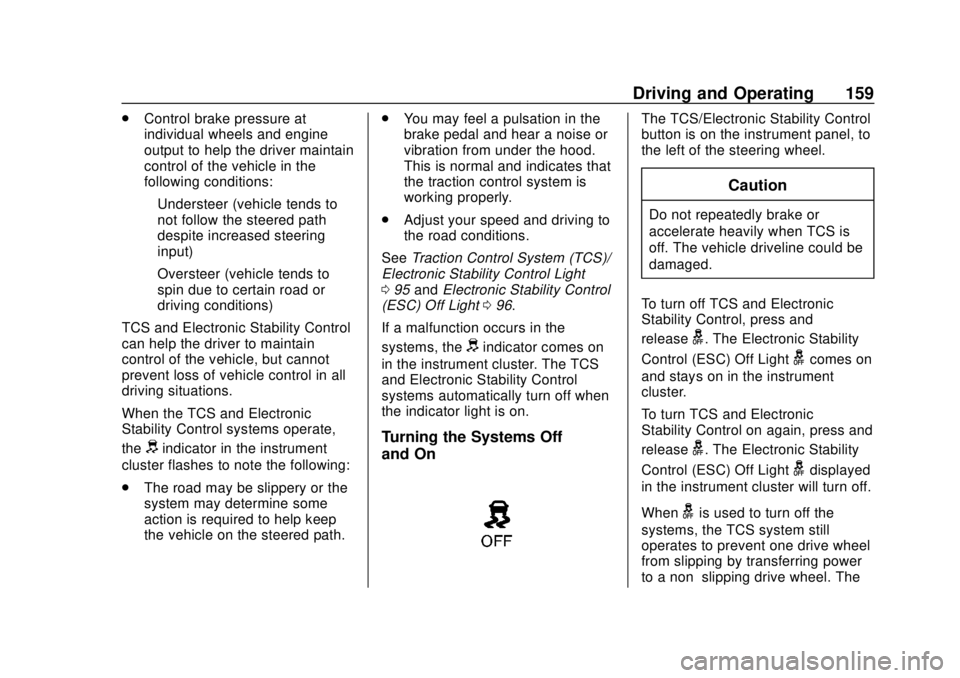
Chevrolet City Express Owner Manual (GMNA-Localizing-U.S./Canada-
11683523) - 2018 - CRC - 7/10/17
Driving and Operating 159
.Control brake pressure at
individual wheels and engine
output to help the driver maintain
control of the vehicle in the
following conditions:
‐Understeer (vehicle tends to
not follow the steered path
despite increased steering
input)
‐ Oversteer (vehicle tends to
spin due to certain road or
driving conditions)
TCS and Electronic Stability Control
can help the driver to maintain
control of the vehicle, but cannot
prevent loss of vehicle control in all
driving situations.
When the TCS and Electronic
Stability Control systems operate,
the
dindicator in the instrument
cluster flashes to note the following:
. The road may be slippery or the
system may determine some
action is required to help keep
the vehicle on the steered path. .
You may feel a pulsation in the
brake pedal and hear a noise or
vibration from under the hood.
This is normal and indicates that
the traction control system is
working properly.
. Adjust your speed and driving to
the road conditions.
See Traction Control System (TCS)/
Electronic Stability Control Light
0 95 and Electronic Stability Control
(ESC) Off Light 096.
If a malfunction occurs in the
systems, the
dindicator comes on
in the instrument cluster. The TCS
and Electronic Stability Control
systems automatically turn off when
the indicator light is on.
Turning the Systems Off
and On
The TCS/Electronic Stability Control
button is on the instrument panel, to
the left of the steering wheel.
Caution
Do not repeatedly brake or
accelerate heavily when TCS is
off. The vehicle driveline could be
damaged.
To turn off TCS and Electronic
Stability Control, press and
release
g. The Electronic Stability
Control (ESC) Off Light
gcomes on
and stays on in the instrument
cluster.
To turn TCS and Electronic
Stability Control on again, press and
release
g. The Electronic Stability
Control (ESC) Off Light
gdisplayed
in the instrument cluster will turn off.
When
gis used to turn off the
systems, the TCS system still
operates to prevent one drive wheel
from slipping by transferring power
to a non–slipping drive wheel. The